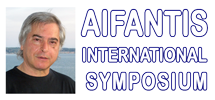List of Accepted Abstracts As of 15 March 2015: (Alphabetical Order)
Aifantis International Symposium
(2nd Intl. symp. on Multiscale Material Mechanics in the 21st Century)
Gudenau International Symposium
(3rd Intl. Symp. on Advanced Sustainable Iron and Steel Making)
Takano International Symposium
(1st Intl. Symp. on Sustainable Metals & Alloys Processing)
Meech International Symposium
(2nd Intl. Symp. on Sustainable Mining Operations)
2nd Intl. Symp. on Sustainable Mineral Processing: Principles, Technologies and Industrial Practice
Vanyukov International Symposium
(3rd Intl. Symp. on Sustainable Non-ferrous Smelting and Processing)
3rd Intl. Symp. on Sustainable Materials Recycling Processes and Products
3rd Intl. Symp. on Quasi-crystals, Metallic Alloys, Composites, Ceramics and Nano Materials
2nd Intl. Symp. on Sustainable Cement Production
4th Intl. Symp. on Environmental, Health, Policy, Legal, Management and Social Issues Related to Metals, Materials and Mineral Processing
2nd Intl. Symp. on Rare Earth and Platinum Group Metals: Managing and Processing
2nd Intl. Symp. on Sustainable Production of Ferro-alloys
3rd Intl. Symp. on Sustainable Molten Salt and Ionic Liquid Processing
2nd Intl. Symp. on Sustainable Secondary Battery Manufacturing and Recycling
2nd Intl. Symp. on Sustainable Base-metal Bio-extraction
2nd Intl. Symp. on Synthesis and Properties of Nanomaterials for Future Energy Demands
2nd Intl. Symp. on Sustainable Energy Production: Gas/Oil/Shale; Coal; Nuclear; Waste/Bioprocessing and renewables: wind/waves
3rd Intl. Symp. on Composite, Ceramic and Nano Materials Processing, Characterization and Applications
2nd Intl. Symp. on Sustainable Surface and Interface Engineering: Coatings for Extreme Environments
1st Intl. Symp. on Physics of Surfaces and Interfaces, from Fundamentals to
Sustainable Applications
1st Intl. Symp. on Advanced Materials and Technologies for
Sustainable Energy and the Environment(AMTSEE)
1st Intl. Symp. on Multifunctional and Smart Materials, Systems and Structures for Sustainability (MSMSSS)
1ST INTL. SYMP. ON MULTIFUNCTIONAL AND SMART MATERIALS, SYSTEMS AND STRUCTURES FOR SUSTAINABILITY (MSMSSS)
Nano and Nanostructured Hybrid Materials Systems for Multifunctional Aplications
F.
Marquis1 ;
1SAN DIEGO STATE UNIVERSITY, DEPARTMENT OF MECHANICAL ENGINEERING, San Diego, United States;
Type of Paper: RegularCarbon nanotubes and graphene are an almost perfect molecule with truly amazing combinations of thermal electrical and structural properties. In order to achieve their full potential, they need to be fully integrated in all sorts of matrices. Full integration requires their development beyond conventional composites so that the level of the non-nano material is designed to fully integrate with the amount of nanotubes and graphene. Here, the nano materials are part of the matrix rather than a differing component, as in the case of conventional composites. In order to advance the development of multifunctional materials integrating nanotubes and graphene, this research is focused on the simultaneous control of the nanoarchitecture, structural, thermal and electrical properties of fully integrated hybrid materials. These are hybrid materials systems designed to surpass the limits of rule of mixtures engineering and composite design. The goals are to implement multifunctional designs to fully mimic the properties of carbon nanotubes and grapheme on larger scales for enhanced thermal and electrical management in addition to the control of other properties such as strength and toughness. These new approaches involve exfoliation, functionalization, dispersion, stabilization, alignment, polymerization, reaction bonding and coating in order to achieve full integration. Typical examples of structural applications of polymeric and ceramic matrices and applications in energy systems, such as capacitors and batteries as well as other material systems, are presented and discussed.
Nanostructured materials: Addressing corrosion and cracking in extreme environments
I.
Roy1 ;G.
Jacob1 ;T.
Roy2 ;K.
Varanasi2 ;
1SCHLUMBERGER, Rosharon, United States; 2MIT, Cambridge, United States;
Type of Paper: RegularTo bring high pressure and high temperature (HPHT) reservoirs on-stream, there is an urgent need to develop advanced alloys, where higher strength allows design of critical wall thicknesses necessary to counter burst and collapse of tubular(s) deployed downhole. However, the presence of sour gases coupled with HPHT, poses significant engineering challenges associated with corrosion, environmental cracking (EC) and hydrogen embrittlement (H2E), especially of high strength alloys. In this area nano-materials can potentially offer some reliefs in abetting reduce susceptibility to EC and H2E while providing necessary strength. Our talk first addresses the technology gaps in alloy requirements for deep-water and sour HPHT. Potentials of harnessing bulk nanocrystalline materials and coating in oil and gas environments will be subsequently addressed. As research in progress, experiments delving into environmental cracking susceptibility of nanocrystalline materials and “surface nanocrystallized” stainless steels in contrast to their coarse grain (CG) commercial counterparts will be discussed. To assess susceptibility of nanocrystalline materials in contrast to its coarse grained counterpart (CG) to EC and H2E, tests (NACE TM0177 - Method C and NACE TM0198-2004 – SSRT) in air and sour environment (with and without cathodic polarization - CP) were performed. A CP of 1100 mV below open circuit potential (OCP) of the alloys in selected sour environment was applied during quasi static tensile tests. In line with recent publications that nano-materials perform better than their CG counterparts, our results affirm that grain refinement and grain boundary engineering abets corrosion performance and EC / H2E susceptibility. Keywords: Development; Energy; Engineering; Materials; Nanomaterials; Strength;
Smart Functional Coatings for Corrosion Protection of AA2024 Alloys
F.
Montemor1 ;R.
Della Noce1 ;
1INSTITUTO SUPERIOR TECNICO, Lisbon, Portugal;
Type of Paper: RegularLight alloys such as AA2024 alloy has found various applications in the transportation industry due to the relatively high strength-to-weight ratio. The precipitation nucleation of intermetallic particles during the manufacturing of the alloy results in the high strength as well as susceptibility towards localized corrosion. One of the most effective strategies to protect the AA2024 alloy consists on the application of chromate-based conversion coatings or on the application of organic coatings modified with chromate-based anti-corrosion pigments. However, chromates are being slowly discarded due to the growing environmental concerns and their carcinogenic effects. Thus, there is a need to find alternative systems that can replace the use of hexavalent chromium pigments.<br />Presently, the design and development of self-healing coatings are considered powerful alternatives for corrosion protection of metallic structures. To guarantee effective corrosion protection, the coating matrices can be modified with smart particles, or smart containers, loaded with corrosion inhibitors that can be triggered by external stimulus, releasing the inhibitor to the active sites. <br />In this work, two different pH sensitive additives were explored as potential smart systems to design self-healing coatings for corrosion protection of AA2024 alloys. The pH sensitive particles were added to commercial water based epoxy primer, individually, or by combining the two types of containers loaded with different corrosion inhibitors, to study the active corrosion protection properties in coatings of industrial relevance.<br />The anticorrosion activity of these additives was investigated by electrochemical impedance spectroscopy and localized electrochemical impedance spectroscopy. The results reveal that an enhancement of the active protection effect can be reached when additives loaded with different inhibitors are combined in the same protective system. Keywords: coatings; Self-Healing; corrosion
Variations for Multifunctional Composites - A Material Family for Solutions of Problems after DDT (Mosquito Killing) and Decontamination of Radioactive Solutions
L.
Kotai1 ;
1RESEARCH CENTRE FOR NATURAL SCIENCES, HUNGARIAN ACADEMY OF SCIENCES, Budapest, Hungary;
Type of Paper: RegularComposites produced from porous foamed volcanic glass and special binders provide us useful materials with different properties and wide variations of application fields. Depending on the nature of the binder, composite properties can be controlled and in this way, magic materials can be manufactured with unusual and unexpected properties, for example, as carriers for controlled releasing of special ingredients (e.g. selective biological mosquito-larvae killing agent) or for encapsulation of harmful materials containing radioactive isotopes (e.g. for treatment of large amount of aqueous waste with low radioactive isotope content).
Using a starch-protein mixture binder (made from wheat flour) and foamed pumicite, a porous composite material is prepared which contains opened and closed pores and thus can be used as carrier material for BTI (Bacillus Thueringiensis Israelensis), a special and selective biological mosquito-larvae killing agent. Mosquito-larvas, in general, live and feed on the water surface of muddy areas. Our carrier material can float on water surface until it is loaded with BTI and releases the active ingredient in 24-28 hours, which is long enough to kill larvas. An important property of the carrier material is that it sinks in water after releasing BTI and decomposes into harmless natural materials.
Using hydraulic binders and pumicite, a "solid sponge" with opened pores is produced. The surface of the composite usually presents a column-like shape. This material can absorb waste water. The water (solvent) can be evaporated on the surface of the composite and thus the solid non-volatile impurities, e.g. isotopes, are kept in the pores. The evaporation can be done by natural evaporation accelerated by air stream or may also be done in a closed system with external heating. The intensity of evaporation is proportional to the free surface area of the composite column (in case of column). The isotope waste filled columns can be treated in processes like cement or glass forming to ensure final deposition. Keywords: Challenges;
« Back To Technical Program
|



